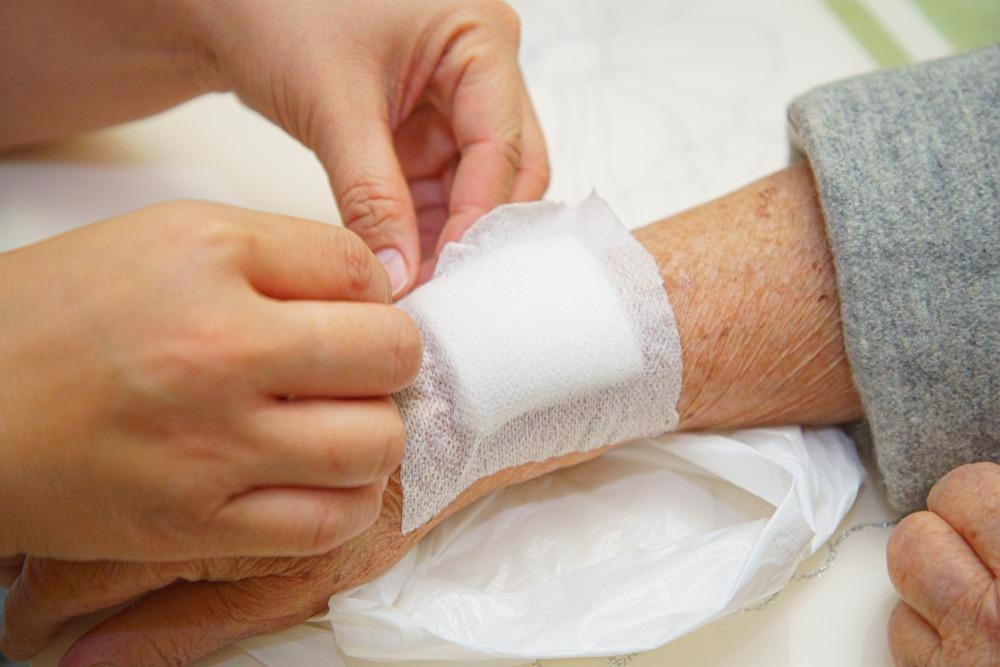Biomaterials have an imperative role in biomedical applications. Hydrogels are one of the most promising classes of biomaterials for biomedical use. In the latest article published in the journal Carbohydrate Polymers, researchers from China developed a novel chitosan (CS)-based metal-organic polyhedrons (MOPs)/enzyme hybrid hydrogel and discussed its application as a superior antimicrobial agent in wound healing treatment.

Study: Novel chitosan based metal-organic polyhedrons/enzyme hybrid hydrogel with antibacterial activity to promote wound healing. Image Credit: BBbirdZ/Shutterstock.com
Wound Healing with Bioengineered Materials
Timely treatment of a wound can avoid bacterial infections and other serious complications. Therefore, developing novel multifunctional wound dressing materials can aid in efficient wound care management.
The alkaline polysaccharide CS has received considerable attention in the biomedical field. The amino group present on CS-based hydrogels destroys the bacterial membrane and disturbs the bacterial wall's mass transport. Although CS-hydrogel has antibacterial properties, its antibacterial effect is limited to the cell wall and further development to widen its antibacterial functions is a challenging task.
MOP's ordered structure, good stability, tunable pore size, and modification sites make it facile to formulate MOPs containing hybrid materials. However, despite their ease of processability, the MOP/biopolymer hybrid hydrogels' application as wound healing materials remains unexplored.
Glucose oxidase (GOx) catalyzed glucose oxidation forms hydrogen peroxide (H2O2) as one of the products. Hence, GOx is a bacteriostatic agent. However, hydroxyl (OH) free radicals are more potent for antibacterial activity than H2O2. Hence, combining MOPs with GOx can be an efficient strategy to generate OH free radicals to treat wound infections.
Novel Hybrid Hydrogel
In the present work, the authors developed a novel CS-based MOPs/enzyme hybrid hydrogel with antimicrobial properties ideal for wound healing treatments. GOx crosslinked with vanadium MOPs (VMOP-2) and CS employing a glutaraldehyde crosslinker to form a novel GOx/VMOP-2/CS (GVCS) hybrid hydrogel. The authors characterized the synthesized GVCS hydrogel by using Fourier transform infrared (FTIR), scanning electron microscope (SEM), X-ray photoelectron spectroscopy (XPS), thermogravimetric analysis (TGA), and energy dispersive X-ray analysis (EDX). The results revealed uniform distribution of VMOP-2 and GOx in hydrogel structure.
In the novel GVCS hydrogel, GOx generates H2O2 from glucose while VMOP-2 converts the formed H2O2 into OH free radicals, thus exhibiting bactericidal activity against both gram-negative bacteria and gram-positive bacteria. Further, the 3-(4,5-dimethylthiazol-2-yl)-2,5-diphenyl tetrazolium bromide (MTT) assay and in vivo studies revealed cytocompatibility and wound healing ability of GVCS hydrogel.
Characterization and Biological Evaluation of GVCS Hydrogel
SEM images of GVCS hydrogel (freeze-dried) showed a honeycomb structure. Moreover, comparing SEM images of CS and GVCS hydrogels showed that the GOx and VMOP-2 addition slightly changed hydrogel morphology. XPS spectrum of GVCS showed five peaks corresponding to S 2s, C1s, N 1s, V 2p, and O 1s.
FTIR spectrum showed characteristic peaks at 3300-centimeter inverse that corresponds to the stretching of OH and amine (NH) groups. The CH2 asymmetric and symmetric stretching vibrations were observed at 2931 and 2869 centimeter inverse, respectively. The peaks at 1646 and 1558 centimeter inverse correspond to amide and amine bending. Further compared to CS gel, peaks at 1646 (amide) and 1033-centimeter inverse (C-OH) had increased intensity in GVCS hydrogel due to imine bonds formed by crosslinking between glutaraldehyde's aldehyde groups and chitosan's amino groups.
TGA studies of GVCS hydrogel revealed that weight loss below 110 degrees Celsius is due to free water loss. Weight loss between 110 and 210 degrees Celsius corroborates loss of bound water and decomposition of the short chain. Furthermore, between 210 and 450 degrees Celsius, the weight loss corresponds to chitosan degradation followed by VMOP-2 decomposition beyond 390 degrees Celsius. The results show that the crosslinking by VMOP-2 improved thermal stability in the GVCS hydrogel. EDX mapping revealed successful GOx and VMOP-2 doping with uniform distribution in the hydrogel structure.
The antibacterial activity of GVCS hydrogel against gram-positive bacteria (Escherichia coli) and gram-negative bacteria (Streptococcus aureus) was better than other hydrogels used (CS, V-CS, GOx-CS). GVCS showed sustained antibacterial activity by utilizing glucose at the wound, which infers that GOx and VMOP-2 constantly generate OH free radicals leading to high antibacterial activity.
The cytotoxicity test of GVCS hydrogel, evaluated by MTT assay on L929 cells, revealed good biocompatibility of the hydrogel. With decreased glucose concentration at the wound, the generation of OH free radicals by GVCS hydrogel reduces, minimizing the irritation, thus confirming the biocompatibility of GVCS hydrogel and its suitability as wound dressing material.
Treating wounds of about 25 square millimeters on the back of mice separately with phosphate buffered saline (PBS), CS, and GVCS hydrogels showed that wound healing was faster in GVCS, suggesting that GVCS hydrogel promotes in vivo wound healing by generating OH radicals with glucose at the wound site.
Results from hematoxylin and eosin (H&E) and Masson's trichrome staining on skin tissue after GVCS hydrogel treatment for 25 days showed matured granulation tissue at the wound in GVCS-treated mice, attributing to faster angiogenesis and fine fibroblasts distribution. Moreover, the dense collagen deposition at the wound site suggests that GVCS hydrogel aids wound closure.
Conclusion
In this study, the authors synthesized a novel CS-based MOP/enzyme hybrid hydrogel that has multiple advantages over current hydrogel-based wound dressing materials. This novel hybrid hydrogel also exhibited superior antibacterial therapy.
Each component of the hybrid hydrogel had a significant contribution to the antibacterial effect.GOx aids in H2O2 generation that is later converted into OH free radical by VMOP-2 and enhances the antibacterial effect. Further, the hybrid hydrogel blocks the nutrient supply to bacteria by consuming glucose at the wound site.
Reference
Song, J., Zhang, C., Kong, S., Liu, F., Hu, W., Su, F. and Li, S. Novel Chitosan-Based Metal-Organic Polyhedrons/Enzyme Hybrid Hydrogel with Antibacterial Activity to Promote Wound Healing. Carbohydrate Polymers (2022). https://www.sciencedirect.com/science/article/pii/S0144861722004271
Disclaimer: The views expressed here are those of the author expressed in their private capacity and do not necessarily represent the views of AZoM.com Limited T/A AZoNetwork the owner and operator of this website. This disclaimer forms part of the Terms and conditions of use of this website.